Isabel
'09 maps for:
Bea
--
Buck -- Caley --
Claws --
Conomo --
Hix --
Hudson 09 -- Isabel --
Katy -- L.R. --
Moffet --
Mr. Hannah --
Ozzie --
Penelope
--
Rafael
2010 maps for: Belle
-- Buck --
Gunny --
Hudson --
Mr. Hannah --
Neale --
North Fork Bob
--
Penelope --
Sanford
-- Sr. Bones --
Thatch
2011 maps:
Belle --
Buck --
Henrietta --
Katbird
-- North Fork Bob --
Pemi --
Saco --
Sanford --
Sr. Bones --
Snowy --
Thatch -- Tucker
2012 maps: Art --
Belle --
Bridger --
Chip --
Cutch --
Jill -- North Fork Bob --
Rammie --
Snowy --
Sr. Bones -- Thatch
2013 maps: Art --
Belle --
Bridger --
North Fork Bob --
Rammie --
Snowy --
Sr. Bones
Osprey
main page --
Migration
page --
Migration09 --
Migration10 --
Migration 11 --
Migration 12 --
Migration 13 -- Home
Page
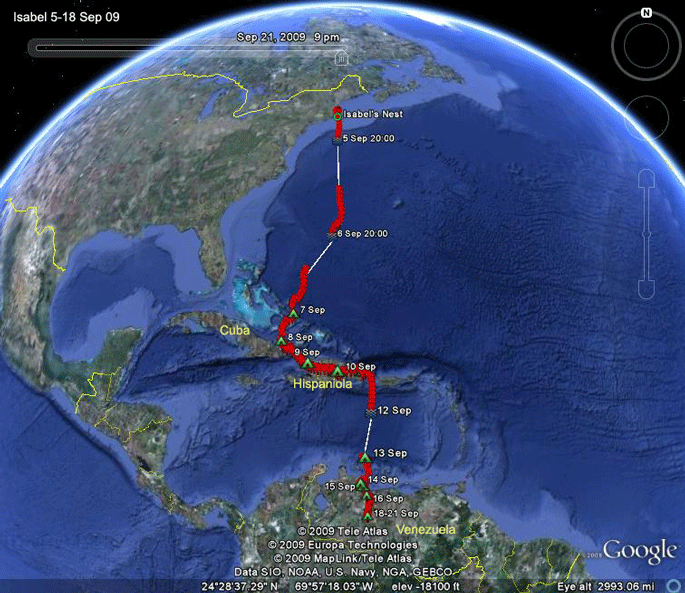 |
Travels so far. Isabel sent her last signal on 21 Sept. She has cleared her last long open-water crossing
and worked her way down into Venezuela, where it looked like she was
settling down. Three days later, her transmitter quit. After a month of staying pretty close to home, she started wandering all over Martha's Vineyard on the 4th, went back home that night and then caromed around the island on the 5th, finally heading south around 11:00. 57 hours later, she had crossed 1,369 miles of the open Atlantic and landed on Crooked Island in the Bahamas, probably around 22:00. By 10:00 the next morning she was on the go, heading for Cuba. This gal is fit! She spent a night in eastern Cuba and then crossed all of Hispaniola in two days. On the 12th she pushed off for points south and made landfall on Bonaire on the 13th, 428 miles (710 km) and 23 hours later. On this water crossing, she was doing less than 20 mph. Hey, you'd be tired, too! She might have had some headwinds. Scroll down for detailed maps of her travels. |
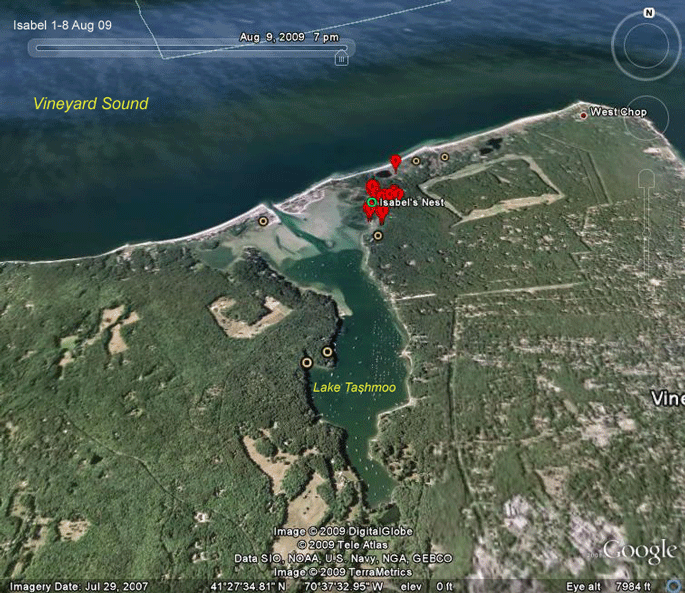 |
1-7 Aug 09. Isabel was born in the same nest as Meadow, our wildly
wandering youngster from '08, and is likely Meadow's full sister. She
had probably been flying for a week or so before we trapped her and
outfitted her with her tracking device. She stayed close to home all week.(Details below.) The Tashmoo/Mink Meadows area has long been a stronghold for Martha's Vineyard Ospreys. This was where one of the two pairs on the whole island nested in the late 1960s. Back then, at the peak of the DDT era, the pair here routinely fledged three or four young, while Ospreys throughout the rest of southern New England were struggling to fledge any. There were seven pairs--over 10% of the Vineyard's nesting population--in the area this year. |
 |
1-7 Aug
09.
Isabel hasn't started to explore much. It will sure be interesting to see if she got some of the same dispersal genes that Meadow had! |
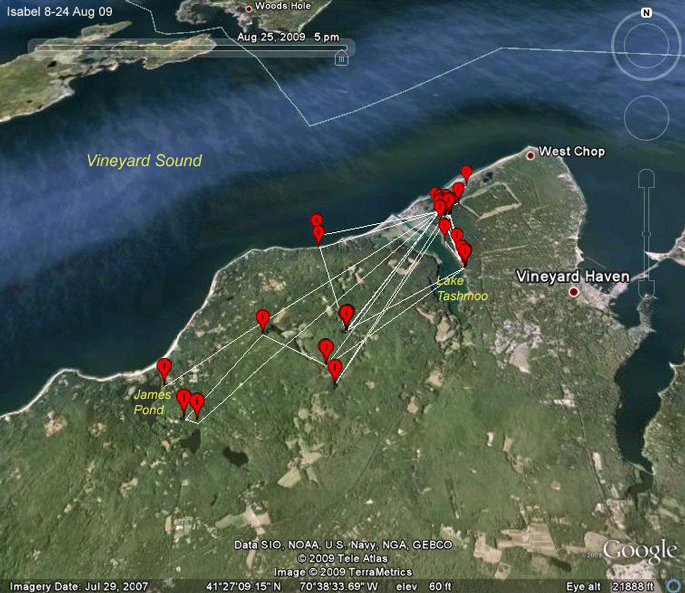 |
8-25 Aug 09. Isabel has left her backyard and is checking out some of the small ponds scattered through the hilly west side of Martha's Vineyard. This area was the terminal moraine of the glaciers that created the Cape and Islands area of southeastern Massachusetts. |
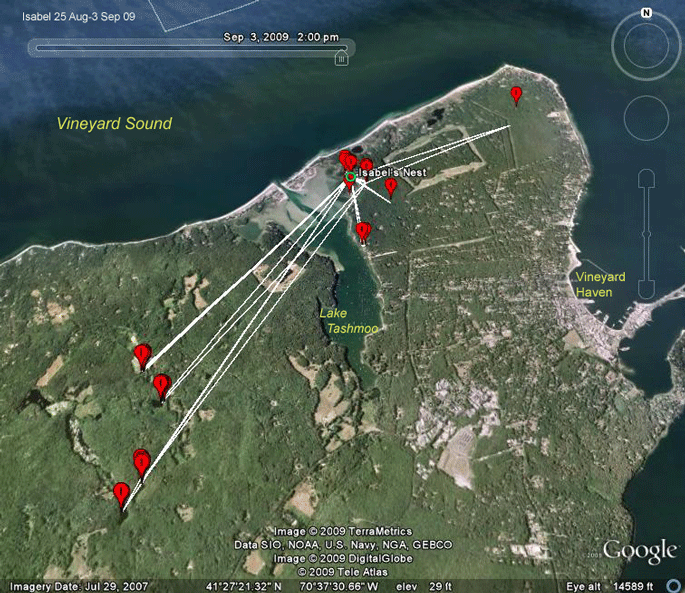 |
25 Aug-3 Sep 09. Isabel is still sticking around her nest, with some forays out to the small ponds just a mile or so from home. |
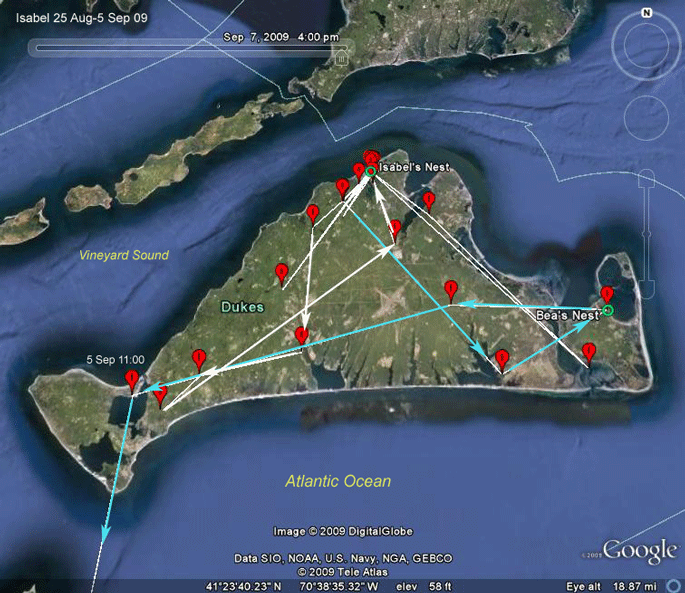 |
25 Aug-5 Sep 09.
Something clicked in Isabel's flight control center
on the 4th (the white arrows indicate her movements that day) and then
on the 5th (blue arrows) she really started bouncing around the Island.
She had a visit with Bea--at least she visited her nest--over on
Chappaquiddick before finally pulling the trigger and heading out over
the Atlantic just after 11:00. She quite clearly didn't get the same dose of pre-migration dispersal genes that drove Meadow to Lake Superior last year. This behavior is quite similar to Tasha, a female we tagged at this same nest back in '04. Tasha just hung around the nest until suddenly just taking off and heading south. |
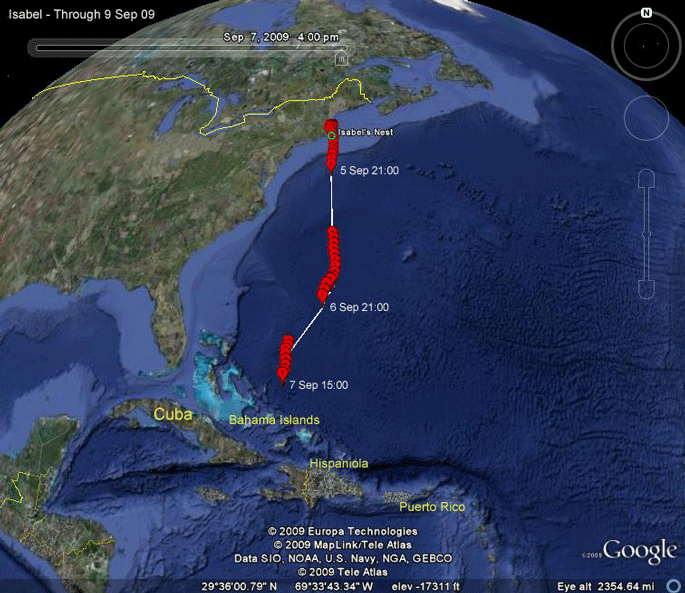 |
5-7 Sep 09. We have to wait
out another cliff-hanger. Our last signals from her were at 15:00 on the
7th, about 56 hours into her ocean crossing. At that point, she had
flown 1,237 miles (1,991 km). She had only about 90 (140 km) miles to go
before hitting the nearest of the Bahaman Islands. There are two kinds of "last signal" messages. The bad one is when a bird dies or a transmitter ceases to function. The other type is when the transmitter just shuts down for the day, which is most likely the case here. The tough part of this is that we now have to wait three days to see if she made it, because the transmitters only talk to the satellites every three days. |
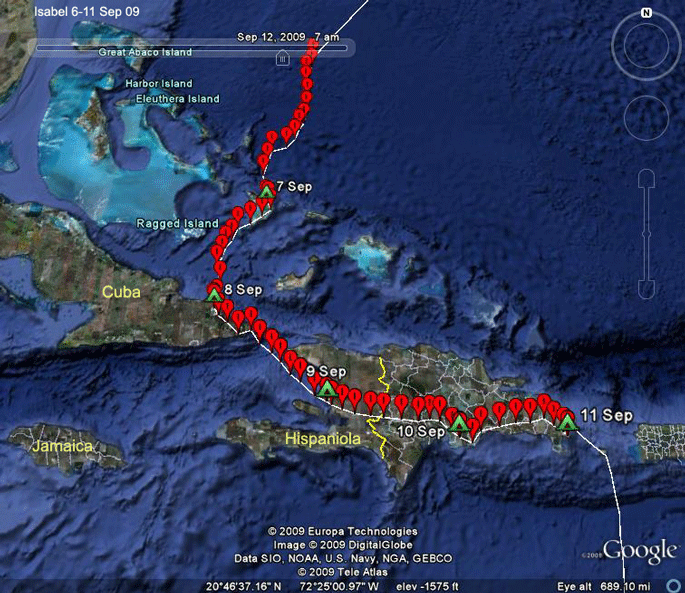 |
7-11 Sep 09. Piece of cake, this Atlantic crossing. Heck, we're not even going to rest up! Isabel arrived on Acklins Island at 09:00 on the 7th and at 10:00 the next morning she was on the wing, heading south. She spent a night on Cuba and then did pretty much all of Hispaniola in two days. She has clocked 2,032 mi. (3,070 km) on the Ospreyometer in just seven days! This may be a record. |
 |
11-13 Sep 09. She started moving about 8:30 on the 12th, left the Dominican Republic about 10:15. She landed on Bonaire 23.5 hours and 455 mi. (732 km) later at 09:45 (more or less). She wandered around Bonaire in search of a much needed breakfast. |
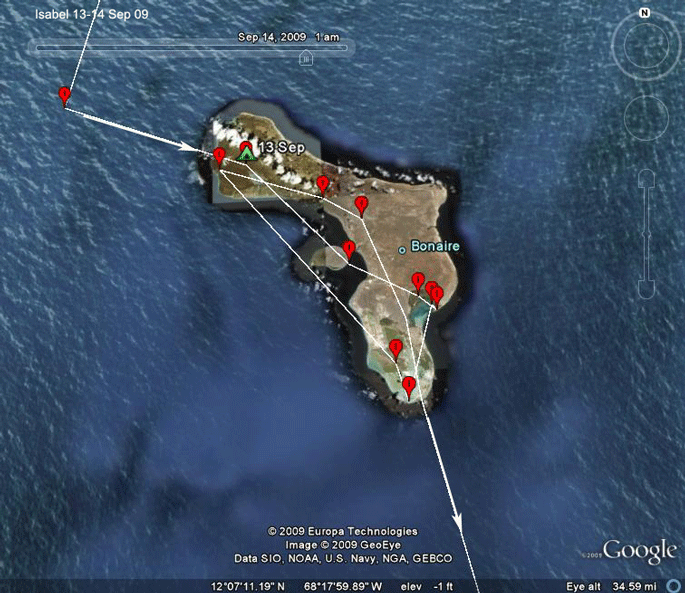 |
13 Sep 09. Looks like she did some fishing on the 13th and some early on the 14th. She left Bonaire at 10:00, with just a short hop to Venezuela. |
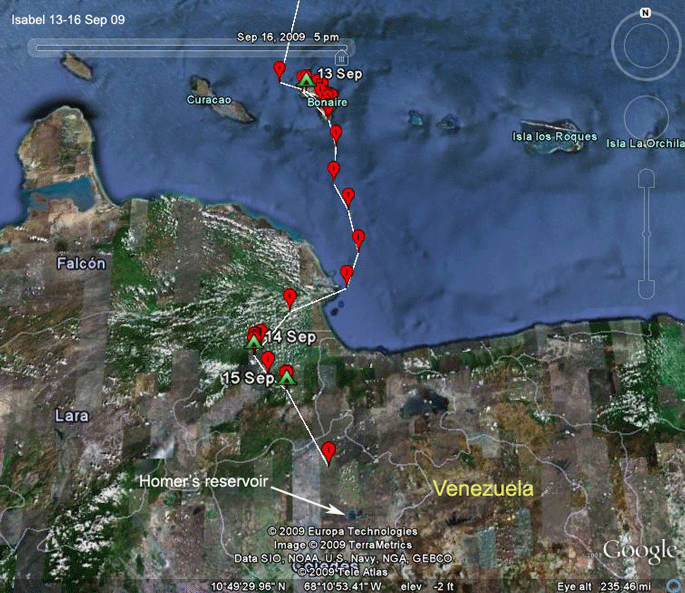 |
13-15 Sep 09. Isabel arrived
in South America a little after 15:00 on the 14th and settled down in
what appears to be an agricultural (probably cattle grazing) landscape
about 40 miles (65 km) from the coast. On the 15th she made a very short
move across some forested, hilly terrain. On the 16th she left her roost
area in the late afternoon (16:00) and was pushing hard to the southeast
when we had our last signal. Intriguingly, she is headed staight for the reservoir where Homer spent his two winters in Venezuela. We know it's good habitat for Ospreys, we we now will wait to see if it attracts Isabel. She's going to get there just around sunset. The real question is, at what point does the migration urge wane to the point where a good fishing spot will stop a bird's southward movement? |
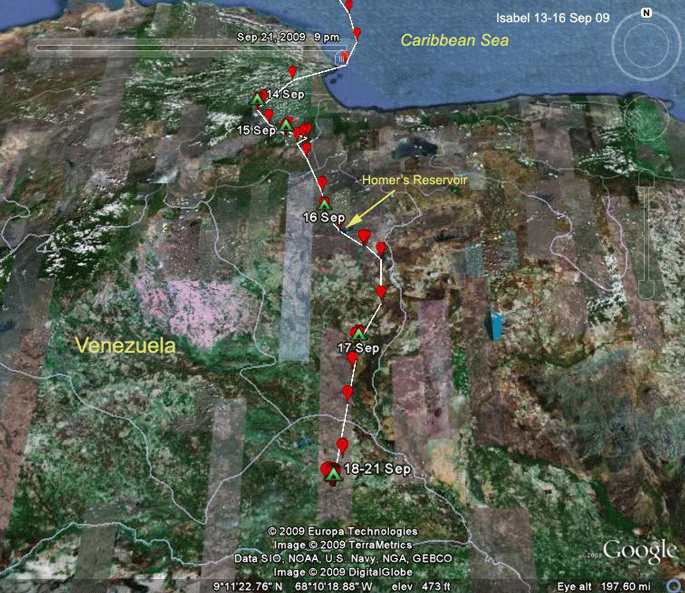 |
14-18 Sep 09. Isabel
continued moving south through Venezuela, at more or less of a snail's
pace, in Osprey migration terms. She covered only 190 miles (301 km)
over these four days. On the 17th she passed over the reservoir that Homer used as his wintering spot for two years. On the 18th she stopped in some cattle-ranching country and stayed put until the 21st, when we lost her signal. |
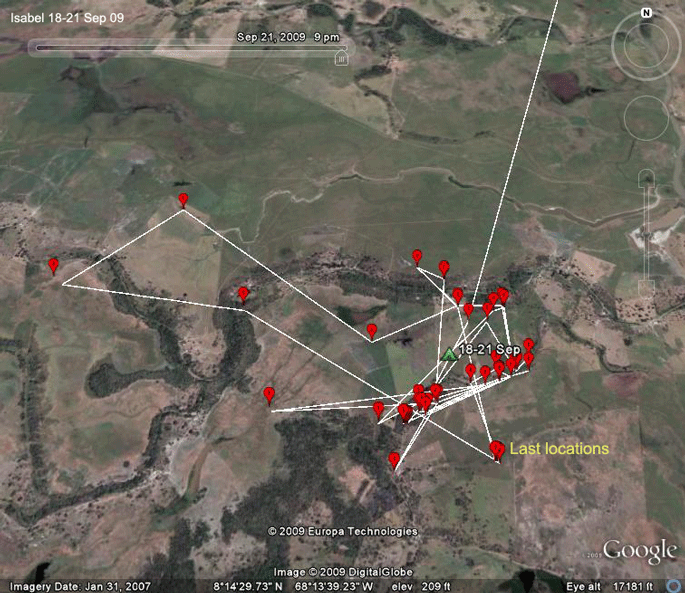 |
18-21 Sep 09. Isabel settled
down for three days in this agricultural landscape near Calabacito, in
the state of Barinas. Her transmitter stopped signaling pretty abruptly on the 21st. This one will remain a mystery. While she was in a cattle ranching area, it's hard to pin this one on shooting. There are probably not a whole lot of vaqueiros (cowboys)/square mile out there, and Ospreys aren't going to be seen as a threat to the herd. Predation is always possible, and Great-horned Owls will roost and hunt in isolated patches of woods like the spot where we last heard from Isabel. Disease and starvation are possible, but she seemed to be moving along well, so this just doesn't seem right. As much insight as we get from the new GPS transmitters, there are times when we just have to admit we don't know what happened. |
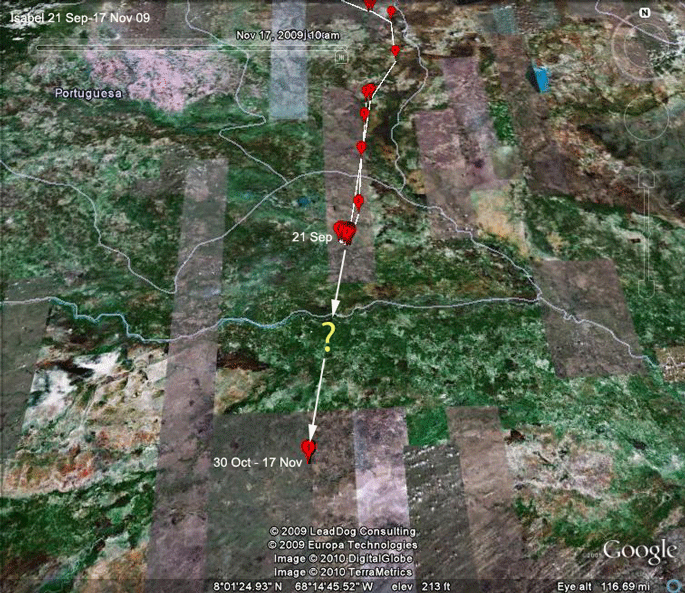 |
21 Sep 09. Isabel's transmitter moved about 50 miles! This one is a total mystery just begging for some conspiracy theorists to step in. |
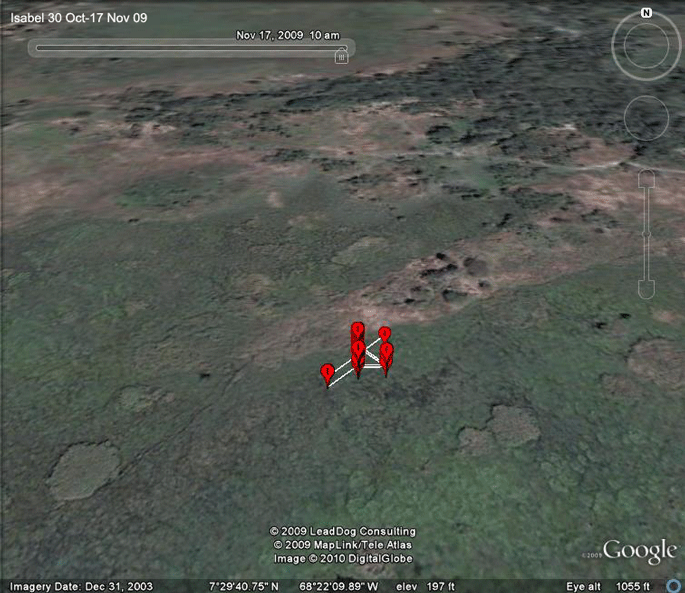 |
30 Oct - 17 Nov 09. About 5
weeks after the last transmissions from Calabacito, we started getting
signals from Isabel's transmitter 53 miles (85 km) south of the last
transmission location, with no points in between. We have absolutely no
idea what happened here. There had to have been a malfunction in the
radio. Had the new locations been in a city or at least from near a
house or ranch, we would assume the bird had been shot, but these
signals were coming from the middle of some savanna. We were getting strong signals for so long that it made sense to send a mission after the transmitter. My Venezuelan colleague Adrian Naveda-Rodrigues set off to try to recover the transmitter. Scroll down for some the rest of the story. (coming soon...) |
Birds of Prey page -- Osprey main page -- Migration page -- Home Page